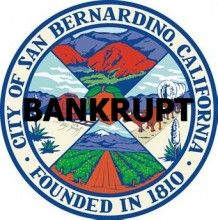San Bernardino bankruptcy shows pensions crowding out services

 In his novel “The Sun Also Rises,” California novelist Ernest Hemingway wrote, “How do you go bankrupt? Two ways: Gradually, then suddenly.”
In his novel “The Sun Also Rises,” California novelist Ernest Hemingway wrote, “How do you go bankrupt? Two ways: Gradually, then suddenly.”
Case in point: the City of San Bernardino, which filed for bankruptcy in 2012. The pace of municipal bankruptcy there has been slow because in 2013 the city resumed making its pension fund payments to the California Public Employees Retirement System.
The city’s recently elected mayor, Carey Davis, has been telling CalPERS to stand in line with other creditors and be prepared to take a loss on its unpaid past pension payments. From August 2012 to July 2013, the city failed to make $17 million in payments to CalPERS, a sum the city now wants CalPERS to absorb.
The wrangling is part of the ongoing court case, where some progress apparently is being made even though CalPERS still is contesting an earlier court ruling that the city is eligible to file for bankruptcy. The Riverside Press-Enterprise reported:
“Nearly two years after San Bernardino declared bankruptcy, the city had good news for U.S. Bankruptcy Court Judge Meredith Jury at a recent hearing.
“ ‘There has been significant and substantial progress as a result of extended good-faith negotiations with CalPERS,’ said lawyer Paul Glassman, who represents the city in the Chapter 9 municipal bankruptcy case.
“The announcement was stunning, given that the California Public Employees Retirement System fought San Bernardino’s bankruptcy filing from the start and is still fighting Jury’s ruling that the city is eligible for bankruptcy protection.”
CalPERS realizes that, if San Bernardino succeeds in using bankruptcy to write down unpaid debts, more cities in California will do so. The sudden domino effect of distressed California cities lining up for bankruptcy would have political repercussions beyond just CalPERS. San Bernardino has $400 million in debts owed subject to bankruptcy, many of them to other public agencies.
Settlement
The San Bernardino City Professional Firefighters union’s lawyer, David Goodrich, indicated it might be willing to consider a settlement with the city through the court-appointed mediator if the outcome is kept confidential from its union members.
It isn’t just the pensions. Cash-strapped cities like San Bernardino have been forced into bankruptcy partly because they must now pick up the tab for the state’s lower spending on local government services. The situation will get worse when the state can no longer ignore $6 billion in annual unfunded health care costs for government retirees and teachers’ pensions.
The City of San Bernardino’s bankruptcy isn’t all due to its own financial mismanagement. It is due to the state’s pension systems crowding out local government services.
Gov. Jerry Brown’s January budget proposal for fiscal year 2014-15, which begins on July 1, conceded that $4.5 billion a year more will be needed to keep solvent the California State Teachers’ Retirement System. But the budget did not include any solutions to the CalSTRS deficit, postponing them to the future. The budget did include some whittling away at what he calls the state’s Wall of Debt, estimated to total more than $300 billion.
The governor’s May Revision to his budget will released early next month. But it likely will not include any solutions to that problem because the governor is in re-election mode and wants to get past November to undertake any new big projects.
In the meantime, the sun is just beginning to rise in San Bernardino and elsewhere as to the consequences of California’s lucrative guaranteed government pensions.
Related Articles
Mulling a majority-vote budget
JULY 6, 2010 By JOHN SEILER With yet another state budget not passed by the July 1 beginning of the
Big Brother in your car?
APRIL 8, 2010 By KATY GRIMES Sen. Alan Lowenthal, D-Long Beach, has introduced a bill that would require the Department of
Confusion: Each Calif. state agency uses different accounting numbers
Aug. 20, 2012 By Wayne Lusvardi In 15th century Italy, the Medici Bank issued two sets of currency: gold Florins for


